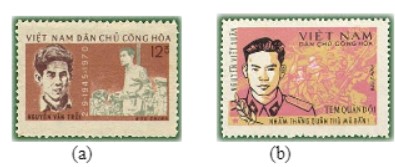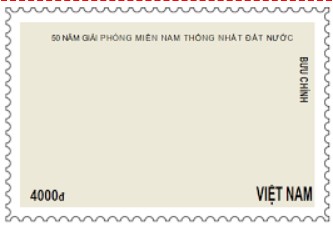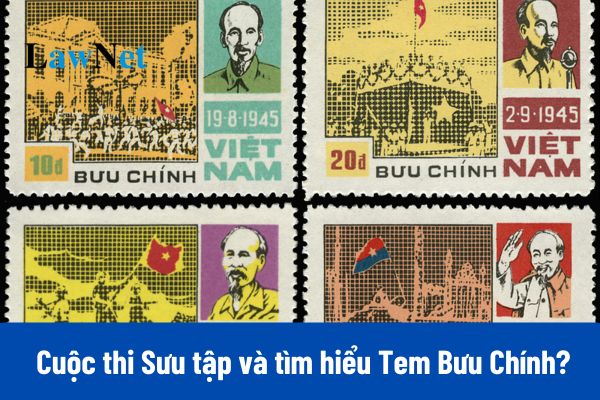What are the questions and answers to the "Collect and Learn About Postage Stamp" contest 2025 in Vietnam?
What are the questions and answers to the "Collect and Learn About Postage Stamp" contest 2025 in Vietnam?
On November 27, 2024, the Central Council of Ho Chi Minh Young Pioneer Organization, in cooperation with Vietnam Post Corporation and the Vietnam Philatelic Association, issued Plan 5416/KH-HDDTW/BDVN/HTVN to organize the "Collect and Learn About Postage Stamp" contest 2025 with the theme "50 Years of Southern Liberation and National Unification through Postage Stamps".
Below are the questions and answers to the "Collect and Learn About Postage Stamp" contest 2025 in Vietnam:
Question 1: Please arrange the following stamp designs in the order of historical events in the resistance war against the US:

Answer: The correct order of the stamps: (a) => (e) => (d) => (c) => (b)
In which
(a) Commemorative stamps for the 50th Anniversary of the Tet Offensive and Uprising (1968-2018).
(e) The stamp series “50th Anniversary of the Establishment of the Provisional Revolutionary Government of the Republic of Southern Vietnam (1969-1976)”.
(d) Stamp pattern from the "50th Anniversary of the 12-day-and-night Battle 'Hanoi-Dien Bien Phu in the Air' (1972-2022)".
(c) The signing ceremony of the Paris Agreement on ending the war and restoring peace in Vietnam, on January 27, 1973, at the International Conference Center in Paris (France).
(b) Stamp Serie 320 - General Offensive 1975.
Question 2: During the resistance war against the US, many roads and locations are associated with the glorious victories of our army and people. Please speak about the victories depicted on the following stamp designs:

Answer:
(a) The Ho Chi Minh Trail, also known as the “Truong Son Route,” is a strategic military logistics network running from North to South Vietnam, through Central Vietnam, Lower Laos, and Cambodia. This transportation system played a role in supplying troops, food, and weaponry to support the liberation forces of the South and the People’s Army of Vietnam during 16 years (1959 - 1975) of the Vietnam War. The Truong Son Army Corps (559) of the People’s Army of Vietnam deployed engineering, logistics, medical, infantry, and air defense forces to ensure the operation of this route. This road was also called the “Inflamed Line” by combat soldiers. According to official historical documents from the National Security Agency of the United States, the Ho Chi Minh Trail was considered by the US military as “one of the great achievements of military engineering of the 20th century.”
(b) The Quang Tri Citadel - The Battle for the Liberation of Quang Tri, and the event of 81 days and nights defending the Quang Tri Citadel in 1972 is an important event in the resistance war against the US, contributing decisively to the victory on the diplomatic front, forcing the US to sign the Paris Agreement, paving the way for the Spring 1975 victory, liberating the South, unifying the country.
(c) The Victory at Khe Sanh, the Liberation of Huong Hoa contributed to a decisive turning point in the resistance war against the US. This great victory inspired the entire nation and friends all over the world; it stands as evidence of our Communist Party’s successful, intelligent, and strategic military leadership; and remains an epic of the nation and military, a proud source of motivation for the Quang Tri army and people, and a great spiritual motivator for the Communist Party and people of the ethnic groups in Huong Hoa district in the journey of building and developing the homeland.
(d) The 1960 Uprising Movement in Ben Tre opened a new situation with prospects for the southern revolution, contributing to creating a strategic turning point, shifting the South revolutionary from decline, from preserving forces to advancing strategic offensive, signaling the collapse of the US-dictated pro-government policies.
(e) The Spring 1975 Victory shattered over 1 million puppet army troops, completely overthrowing puppet government policies in the South dictated by the US, prompting American advisors to leave the South, forcing Puppet President Duong Van Minh to declare unconditional surrender. That victory liberated the South’s people from imperialist and puppet rule.
The Great Spring 1975 Victory marked the end of 21 years of resistance against the US, concluding 30 years of national liberation and defense, permanently ending the domination of French-US imperialist and feudal policies, and cleansing the 100-year humiliation of subjugation inflicted on the Vietnamese people.
Question 3: Many heroes among our troops and people were honored or posthumously awarded People's Armed Forces Heroes during the liberation struggle for the reunification of the South. Please tell us some details about the hero depicted on the stamp below.

Answer:
(a) Nguyen Van Troi (1940–1964)
Nguyen Van Troi was born on February 1, 1940, in Thanh Quyt village, Dien Ban district, Quang Nam province. After the Geneva Accords, he moved with his family to Saigon and worked as an electrician at the Cho Quan power plant. Here, he became aware of the revolution and joined an armed commando group under the Quyết Tử (Determined to Die) Regiment 65.
In early 1964, he went to the Rừng Thơm base (Duc Hoa district, Long An) to study politics and commando techniques. In May of the same year, when the US delegation led by Secretary of Defense Robert McNamara visited Saigon, he volunteered for the assassination mission. However, while planting mines on Cong Ly Bridge, he was caught on the night of May 9, 1964.
Despite being brutally tortured in prison, Nguyen Van Troi remained steadfast and did not disclose any information. The Nguyen Khanh regime brought him to a military trial and sentenced him to death to intimidate the resistance movement. On the morning of October 15, 1964, he was executed at Chi Hoa prison at the age of 24.
After his death, the Communist Party of Vietnam posthumously awarded him the title of Party member and the First Class Dong Medal.
(b) Nguyen Viet Xuan (1934–1964)
Nguyen Viet Xuan was born in 1934 into a poor family in Ngu Kien commune, Vinh Tuong district, Vinh Phuc province. At 18, he crossed the occupied zone to join the People’s Army of Vietnam in 1952 and became an anti-aircraft gunner.
During the Dien Bien Phu campaign, his unit shot down many enemy planes. He was particularly influenced by the sacrifice of his commander Nguyen Khac Vy and continuously advanced, becoming the company's political instructor.
In 1964, he and his anti-aircraft unit marched to western Quang Binh, defending the northern skies. In a ferocious battle, he was severely wounded in the leg. Despite the pain, he continued to lead and keep the fighting spirit of his comrades high. Later, due to serious injuries, he died in action.
His command "Aim straight at the enemy... fire!" became a symbol of indomitable fighting spirit, scaring the enemy.
Question 4: In 2025, the whole nation joyfully commemorates the 50th anniversary of the Liberation of the South and National Reunification. In this struggle, there were numerous exemplary stories of soldiers and fighters directly involved in the combat. Can you tell a story about an exemplary figure you know (not to exceed 1,000 words) or draw a stamp design (A4 size) to depict this historical event?

Answer:
The Heroic Example of Vo Thi Sau – The Immortal Flower
In the resistance war against the French colonialists, countless heroic examples have sacrificed for national independence. One of the distinguished children of our country is Vo Thi Sau, the steadfast daughter of Dat Do land, Ba Ria-Vung Tau. Although very young, she fought bravely and became an eternal symbol of Vietnamese revolutionary heroism.
Vo Thi Sau was born in 1933 into a poor labor family. Growing up amidst the oppression by the French colonialists, she soon became aware of the revolution and joined the police vanguard at the age of 14. Her duties were to monitor, punish informers, and supply food and weapons to the soldiers.
In 1948, during a mission to throw a grenade to eliminate a notorious informer, she was discovered. However, with quick thinking and courage, she promptly withdrew safely.
In 1950, during another mission, Vo Thi Sau was unfortunately captured. The enemy tortured her inhumanely, but she resolutely refused to disclose any information. The colonial government brought her to trial and sentenced her to death before she was even 18. In prison, she maintained an optimistic and lively spirit. She sang revolutionary songs, encouraging other prisoners. This left the enemy both in awe and fear.
On January 23, 1952, Vo Thi Sau was taken to Con Dao for execution. On the way, she was calm, singing revolutionary songs. When the enemy insisted on blindfolding her, she declared boldly:
"I have committed no crime and need no blindfold! Let me see my country one last time!"
Her words caused the enemy to tremble. Even when facing the enemy's guns, she stood fearless and unyielding. The gunshots were fired, but her spirit forever resonates. Vo Thi Sau's image is not only a pride of Vietnamese women but also a symbol of patriotism and unyielding spirit for the younger generation. She was posthumously awarded the title of Hero of the People's Armed Forces, and today, her grave at the Hang Duong Cemetery in Con Dao is always adorned with fresh flowers, showing the infinite gratitude of later generations.
Vo Thi Sau – the immortal flower of the nation, remains a pride of Vietnam!
Note: Information is for reference purposes only!

What are the questions and answers to the "Collect and Learn About Postage Stamp" contest 2025 in Vietnam? (Image from Internet)
What are the regulations on the format of entities for the "Collect and Learn About Postage Stamp" contest 2025 in Vietnam?
According to Plan 5416/KH-HDDTW/BDVN/HTVN, the "Collect and Learn About Postage Stamp" contest 2025 with the theme "50 Years of Southern Liberation and National Unification through Postage Stamps" will be showcased as follows:
- Contest entries can be handwritten or typed, presented on A4 paper or clean grid paper, without wrinkling, erasing; answers must be complete, with clear, concise, and logical language, arranged in the correct order of questions, without photocopied entries or identical submissions.
- Entries must be unpublished in any books, newspapers, magazines, or media. Contestants must fully bear the copyright and responsibility in case of disputes regarding the copyright of the entries.
- Handwritten entries are encouraged, collecting many stamps to support the entry (images and documents must be official and clearly annotated).
- Entries must clearly include the full name, date of birth, school, class, school address, home address, and phone number (if any); entries lacking personal information are invalid.
- Entries should be sent to the Organizing Committee, with the envelope clearly labeled: Entry for the "Collect and Learn About Postage Stamp" contest 2025 with the theme “50 Years of Southern Liberation and National Unification through Postage Stamps.”
- The Organizing Committee has full ownership and the right to use the works for propaganda purposes after the contest; is not responsible for entries lost or damaged during transit; and will not return submitted or prize-winning entries.
What types of compositions must 5th-grade students in Vietnam be able to write?
According to the General Education Program issued with Circular 32/2018/TT-BGDDT, 5th-grade students are required to be able to write a complete short essay, mainly narrative essays, descriptive essays, and simple introductions.
5th-grade students must be able to write essays retelling stories they have read, events they have witnessed or participated in, and stories they have imagined;
They must describe familiar objects and phenomena; introduce objects and activities closely related to their lives. They must also know how to write a paragraph expressing their emotions and thoughts when reading a story or poem or seeing an event that evokes many emotions;
They should express opinions on simple issues in study and life; know how to write certain text types such as autobiographies, messages, invitations, schedules, letters, etc.; and start to know how to write according to a process. A composition should consist of three parts (introduction, body, conclusion).

